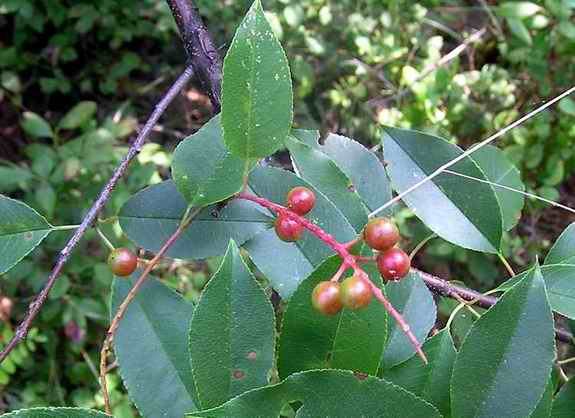|
Common Name: Chokecherry, Eastern Chokecherry, Western Chokecherry (the common name refers to the astringency of the fruit, especially when immature) Scientific Name: Prunus virginiana (The generic name is Latin for plum tree, to which all native plum and cherry trees belong; the species denotes Virginia, where they were first noted by botanists of Colonial America)
The chokecherry was a very important part of the diet of Native Americans. The berries were collected in the fall and dried or frozen so that they could be consumed during the winter months, an important source of vitamins A and C. Often, the fruits were pounded into a flour-like material that was stored in cakes for use after rehydration in soups or sauces or as an additive to other foods, such as pemmican. They were so important to the Lakota (who called them Canpa'hu meaning bitterwood stem) that one of their summer months was called Canpasapa-wi, the month when cherries are ripe.
Pemmican is a mixture of meat, fruit and fat that was one of the primary means of sustenance for Indians during long journeys or hunts. The word pemmican is from the Cree and Abnaki word pimikan, which literally means "made with fat." A pimikeu (one who makes grease) boiled crude fat (pimu) in water to skim off the concentrated, supernatant oil. This was added to the meat of deer or fish (according to food preference and geographic availability; the Inuit use deer meat and seal oil) that was cut into thin strips and either dried in the sun or smoked over a low fire. Chokecherries were then ground into the mix to make pemmican, which was compressed in bags made from animal skins. If kept relatively dry, this mixture would keep for as long as five years. William Clark writes in his diary entry of September 26, 1804, near Fort Pierre, South Dakota that "�we were requested to take the meal. (put before us the dog which they had been cooking and Pemitigon and ground potatoe [sic] in several platters.)"
The name chokecherry may also have been given to P. virginiana by early settlers as a means of deterring consumption by children, as parts of the plant are poisonous. The cherry pits and, to a lesser extent, the leaves and bark contain cyanogenetic glycoside which is a toxin that breaks down to hydrocyanic acid in the body. There have been reports of livestock having been killed by eating too many chokecherry leaves and of children who have been poisoned by eating too many seeds. However, as heating renders the toxin harmless, the sun-drying process used by Indians allowed for their copious consumption of the ground berries and pits without deleterious effects.
Chokecherry was also a very important medicinal herb to Native Americans. The bark was the primary source of palliative treatments, particularly the cambium, a layer of specialized cells between the bark and the wood generally referred to as inner bark. The bark was soaked in a water bath and used as a tonic to treat a variety of ailments including coughs, sore throats and other pulmonary troubles (Penobscot Indians), a purging agent (Blackfoot Indians), and eyewash (Potawatomi Indians). The berries were dried and powdered and used to treat diarrhea and other digestive complications. Early American herbalists learned of the medicinal properties of chokecherry and characterized it as astringent, narcotic, stimulant and pectoral. It was listed in the U. S. Dispensatory in 1820 and was used to treat mild fever, worms, dyspepsia, consumption (usually tuberculosis), phlegm congestion and bronchitis.
The wood of the chokecherry was also important to Native Americans as it was very hard and did not burn easily. Consequently, forked sticks of chokecherry wood were used to carry hot rocks from the campfire to sweat lodges and hot coals from an extant fire to make a smoke producing fire called a smudge (to smoke meat for pemmican perhaps). The hardness made it ideally suited for making tent pegs, digging sticks and other similar household tools. Green dye was made from the bark; red dye was made from the berries.
Due to the importance of the chokecherry to the Native Americans, it quickly became a staple of the early pioneers. The Lewis and Clark Corps of Discovery noted chokecherries the second day they were in Nebraska waters in July, 1804. One of the diarists of the expedition noted on July 19, 1804 that "the men pulled a great quantity of wild cherries put them in a barrel of whiskey." The last of the whiskey was consumed on the 4th of July 1805, with no mention of the disposition of the chokecherries. William Clark noted in his diary in the winter of 1804-1805 in Fort Mandan, North Dakota that "this country abounds in a variety of wild fruit, such as chokecherries."
The chokecherry was widely assimilated into early American culinary and pharmacological practices to create a wide variety of foodstuffs and medicines. Jams, jellies and syrups are made from the berries, which can be fermented to make wine. The patent medicine that was pedaled by itinerant merchants in the stereotypical medicine show was generally a decoction of chokecherry twigs, leaves and bark mixed with honey. |
